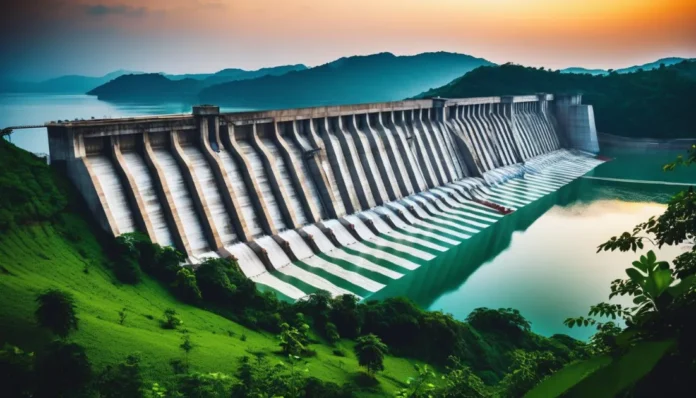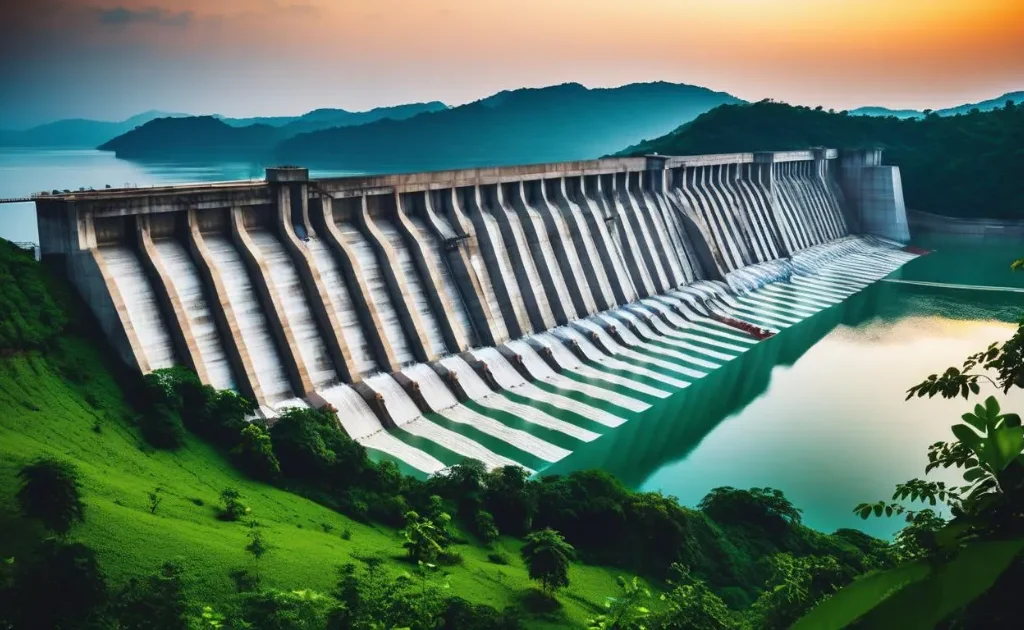Table of Contents
List of Dams and Reservoirs in India: A Detailed Overview
India is home to numerous dams and reservoirs, which play a vital role in irrigation, power generation, flood control, and water supply. From the towering Bhakra Nangal to the picturesque Hirakud Dam, each of these marvels of engineering contributes significantly to India’s infrastructure. In this article, we’ll explore a comprehensive list of dams and reservoirs in India, delving into their importance, types, and the regions they support.
Introduction to Dams and Reservoirs in India
India has a vast network of dams and reservoirs scattered across its landscape, serving multiple purposes such as irrigation, water supply, hydroelectric power generation, and flood control. These structures are critical to supporting the nation’s agricultural demands, energy requirements, and growing population. With a history of dam building dating back to ancient times, India has embraced modern dam engineering to meet its present-day needs.
| Dam Name | State | River |
|---|---|---|
| Nizam Sagar Dam | Telangana | Manjira River |
| Somasila Dam | Andhra Pradesh | Pennar River |
| Srisailam Dam | Andhra Pradesh | Krishna River |
| Singur Dam | Telangana | Manjira River |
| Ukai Dam | Gujarat | Tapti River |
| Dharoi Dam | Gujarat | Sabarmati River |
| Kadana Dam | Gujarat | Mahi River |
| Dantiwada Dam | Gujarat | Banas River |
| Pandoh Dam | Himachal Pradesh | Beas River |
| Bhakra Nangal Dam | Himachal Pradesh and Punjab Border | Sutlej River |
| Nathpa Jhakri Dam | Himachal Pradesh | Satluj River |
| Chamera Dam | Himachal Pradesh | Ravi River |
| Baglihar Dam | Jammu and Kashmir | Chenab River |
| Dumkhar Hydroelectric Dam | Jammu and Kashmir | Indus River |
| Uri Hydroelectric Dam | Jammu and Kashmir | Jhelum River |
| Maithon Dam | Jharkhand | Barakar River |
| Chandil Dam | Jharkhand | Swarnarekha River |
| Panchet Dam | Jharkhand | Damodar River |
| Tungabhadra Dam | Karnataka | Tungabhadra River |
| Linganamakki Dam | Karnataka | Sharavathi River |
| Kadra Dam | Karnataka | Kalinadi River |
| Alamatti Dam | Karnataka | Krishna River |
| Supa Dam | Karnataka | Kalinadi or Kali River |
| Krishna Raja Sagara Dam | Karnataka | Kaveri River |
| Harangi Dam | Karnataka | Harangi River |
| Narayanpur Dam | Karnataka | Krishna River |
| Kodasalli Dam | Karnataka | Kali River |
| Malampuzha Dam | Kerala | Malampuzha River |
| Peechi Dam | Kerala | Manali River |
| Idukki Dam | Kerala | Periyar River |
| Kundala Dam | Kerala | Kundala Lake |
| Parambikulam Dam | Kerala | Parambikulam River |
| Walayar Dam | Kerala | Walayar River |
| Mullaperiyar Dam | Kerala | Periyar River |
| Neyyar Dam | Kerala | Neyyar River |
| Rajghat Dam | Uttar Pradesh and Madhya Pradesh Border | Betwa River |
| Barna Dam | Madhya Pradesh | Barna River |
| Bargi Dam | Madhya Pradesh | Narmada River |
| Bansagar Dam | Madhya Pradesh | Sone River |
| Gandhi Sagar Dam | Madhya Pradesh | Chambal River |
| Yeldari Dam | Maharashtra | Purna River |
| Ujani Dam | Maharashtra | Bhima River |
| Pawna Dam | Maharashtra | Maval River |
| Mulshi Dam | Maharashtra | Mula River |
| Koyna Dam | Maharashtra | Koyna River |
| Jayakwadi Dam | Maharashtra | Godavari River |
| Bhatsa Dam | Maharashtra | Bhatsa River |
| Wilson Dam | Maharashtra | Pravara River |
| Tansa Dam | Maharashtra | Tansa River |
| Panshet Dam | Maharashtra | Ambi River |
| Mula Dam | Maharashtra | Mula River |
| Kolkewadi Dam | Maharashtra | Vashishti River |
| Girna Dam | Maharashtra | Girana River |
| Vaitarna Dam | Maharashtra | Vaitarna River |
| Radhanagari Dam | Telangana | Bhogawati River |
| Lower Manair Dam | Telangana | Manair River |
| Mid Manair Dam | Telangana | Manair River and SRSP Flood Flow Canal |
| Upper Manair Dam | Telangana | Manair River and Kudlair River |
| Khadakwasla Dam | Maharashtra | Mutha River |
| Gangapur Dam | Maharashtra | Godavari River |
| Jalaput Dam | Andhra Pradesh and Odisha Border | Machkund River |
| Indravati Dam | Odisha | Indravati River |
| Hirakud Dam | Odisha | Mahanadi River |
| Vaigai Dam | Tamil Nadu | Vaigai River |
| Perunchani Dam | Tamil Nadu | Paralayar River |
| Mettur Dam | Tamil Nadu | Kaveri River |
| Govind Ballabh Pant Sagar Dam (Rihand Dam) | Uttar Pradesh | Rihand River |
| Tehri Dam | Uttarakhand | Bhagirathi River |
| Dhauli Ganga Dam | Uttarakhand | Dhauli Ganga River |
Importance of Dams in India: List of Dams and Reservoirs in India
Dams are more than just concrete walls holding back rivers; they are lifelines for millions of Indians, providing critical services in various sectors.
Dams for Irrigation and Agriculture
Agriculture is the backbone of India’s economy, and dams play a key role in supplying water to farmlands. India’s diverse climatic conditions make water storage necessary for irrigation during dry periods. The water stored in reservoirs helps regulate the flow of rivers and canals, ensuring that crops receive adequate water even during droughts.
Hydroelectric Power Generation
Hydroelectric dams harness the energy of flowing water to generate electricity. India, being a growing economy, relies heavily on sustainable energy sources. Dams like Bhakra Nangal and Tehri contribute significantly to the national grid, providing renewable energy to millions of homes and industries.
Flood Control and Water Management
Dams help control the destructive forces of floods, especially during the monsoon season. By regulating water flow, dams prevent downstream flooding and mitigate the damage to human lives, agriculture, and infrastructure.
Domestic and Industrial Water Supply
In addition to agriculture and energy production, dams provide a stable water supply for domestic and industrial use. Many cities and towns in India depend on dam reservoirs to meet their drinking water and manufacturing needs.
History of Dam Construction in India
Ancient India and Early Dams:List of Dams and Reservoirs in India
Dams are not a new concept in India. Even in ancient times, small earthen dams were constructed to capture monsoon rainwater for irrigation. One of the earliest known dams, the Kallanai Dam, built by the Chola kings in Tamil Nadu over 2,000 years ago, is still operational today.
Post-Independence Developments
Post-independence, India saw a surge in dam construction, with major projects like the Bhakra Nangal Dam, Hirakud Dam, and Nagarjuna Sagar Dam being launched to address the nation’s growing needs for water and power.
Types of Dams in India
India boasts a variety of dam types, each designed to suit the geographical and environmental conditions of the region.
Gravity Dams
Gravity dams rely on their own weight to hold back water. They are massive structures built with concrete or stone masonry.
Example: Bhakra Nangal Dam
The Bhakra Nangal Dam, located on the Sutlej River, is one of the largest gravity dams in India, standing at 226 meters. It provides hydroelectric power, irrigation water, and flood control for the surrounding regions.
Embankment Dams
Embankment dams are typically made from earth or rock and are built across wide valleys.
Example: Hirakud Dam
Hirakud Dam, situated on the Mahanadi River in Odisha, is the longest earthen dam in the world. It plays a crucial role in flood control, irrigation, and electricity generation.
Arch Dams
Arch dams are curved structures that transfer the water pressure to the valley walls on either side of the river.
Example: Idukki Dam
Located in Kerala, the Idukki Dam is one of the tallest arch dams in Asia and is used primarily for hydroelectric power generation.
Barrages
A barrage is a type of low-head diversion dam that allows water to flow over the top while controlling its flow downstream.
Example: Farakka Barrage
The Farakka Barrage, constructed on the Ganges River in West Bengal, plays an essential role in diverting water to the Hooghly River to prevent siltation in the Kolkata port.
Major Dams in India
Bhakra Nangal Dam (Himachal Pradesh)
The Bhakra Nangal Dam is a towering structure that stands as a symbol of India’s engineering prowess. It serves multiple purposes, including irrigation, hydroelectric power, and flood control.
Hirakud Dam (Odisha)
The Hirakud Dam spans across 25.8 kilometers, making it one of the longest dams in the world. Its reservoir supplies water to irrigate thousands of acres of farmland and produces a significant amount of electricity.
Tehri Dam (Uttarakhand)
Tehri Dam, standing on the Bhagirathi River, is the tallest dam in India. It is a major source of hydroelectric power and supplies drinking water to cities like Delhi and Agra.
Sardar Sarovar Dam (Gujarat)
The Sardar Sarovar Dam on the Narmada River is one of the largest water resource projects in India. It provides water for irrigation and drinking purposes to Gujarat, Maharashtra, and Madhya Pradesh.
Nagarjuna Sagar Dam (Telangana)
One of the largest masonry dams in the world, the Nagarjuna Sagar Dam is a key irrigation and power generation project on the Krishna River.
Notable Reservoirs in India
Gobind Sagar (Himachal Pradesh)
The reservoir formed by the Bhakra Nangal Dam, Gobind Sagar, is one of the largest in India, supplying water for both irrigation and power generation.
Pong Reservoir (Himachal Pradesh)
Located on the Beas River, the Pong Reservoir supports irrigation and hydroelectric power and is a haven for migratory birds.
Indira Sagar Reservoir (Madhya Pradesh)
Indira Sagar, created by the Indira Sagar Dam, is one of the largest reservoirs in India and plays a critical role in power generation and irrigation.
Stanley Reservoir (Tamil Nadu)
Formed by the Mettur Dam on the Cauvery River, Stanley Reservoir is a significant source of water for agriculture and domestic use in Tamil Nadu.
Environmental and Social Impacts of Dams
Displacement and Rehabilitation of People
Large dam projects often require the displacement of communities, leading to social and economic challenges. Rehabilitation of these communities is a critical issue in dam planning.
Impact on Ecosystems and Wildlife
Dams can disrupt local ecosystems, affecting fish populations and other wildlife. Changes in river flow also impact downstream habitats.
Sedimentation and Siltation Issues
Over time, reservoirs experience sediment build-up, reducing their capacity to store water. This phenomenon, known as siltation, can limit the effectiveness of dams in irrigation, power generation, and flood control. Managing sediment through dredging or other techniques is critical to maintaining a dam’s long-term functionality.
Conclusion
Dams and reservoirs are crucial for India’s development, addressing the country’s needs for irrigation, power generation, water supply, and flood control. From the colossal Bhakra Nangal to the historic Hirakud and modern marvels like the Sardar Sarovar, these engineering feats have helped shape India’s progress. However, while dams offer numerous benefits, they also present significant environmental and social challenges, such as displacement, ecological disruption, and sedimentation. A balanced approach that considers both development and sustainability is essential for the future of dam construction and management in India.
FAQs
List of Dams and Reservoirs in India: A Detailed Overview
What is the largest dam in India?
The Tehri Dam in Uttarakhand is the largest dam in India, standing at 260.5 meters (855 feet). It’s also the tallest dam in the country and is primarily used for generating hydroelectric power and providing water for irrigation.
How do dams benefit agriculture in India?
Dams store water during the rainy season and release it during dry periods, ensuring a continuous supply of water for irrigation. This helps farmers cultivate crops year-round, boosting agricultural productivity and supporting food security.
What are the environmental challenges associated with dams?
The construction of dams can lead to the displacement of communities, disruption of ecosystems, and changes in river flow patterns. Sedimentation in reservoirs also reduces their capacity over time, impacting their long-term viability.
How many dams are there in India?
India has over 5,200 large dams, according to the National Register of Large Dams. These include major dams like Bhakra Nangal, Hirakud, and Nagarjuna Sagar, as well as numerous smaller dams and reservoirs.
Which state has the most dams in India?
Maharashtra has the most dams in India, with over 1,800 large and small dams. The state relies on its extensive network of dams for irrigation, drinking water, and power generation.


